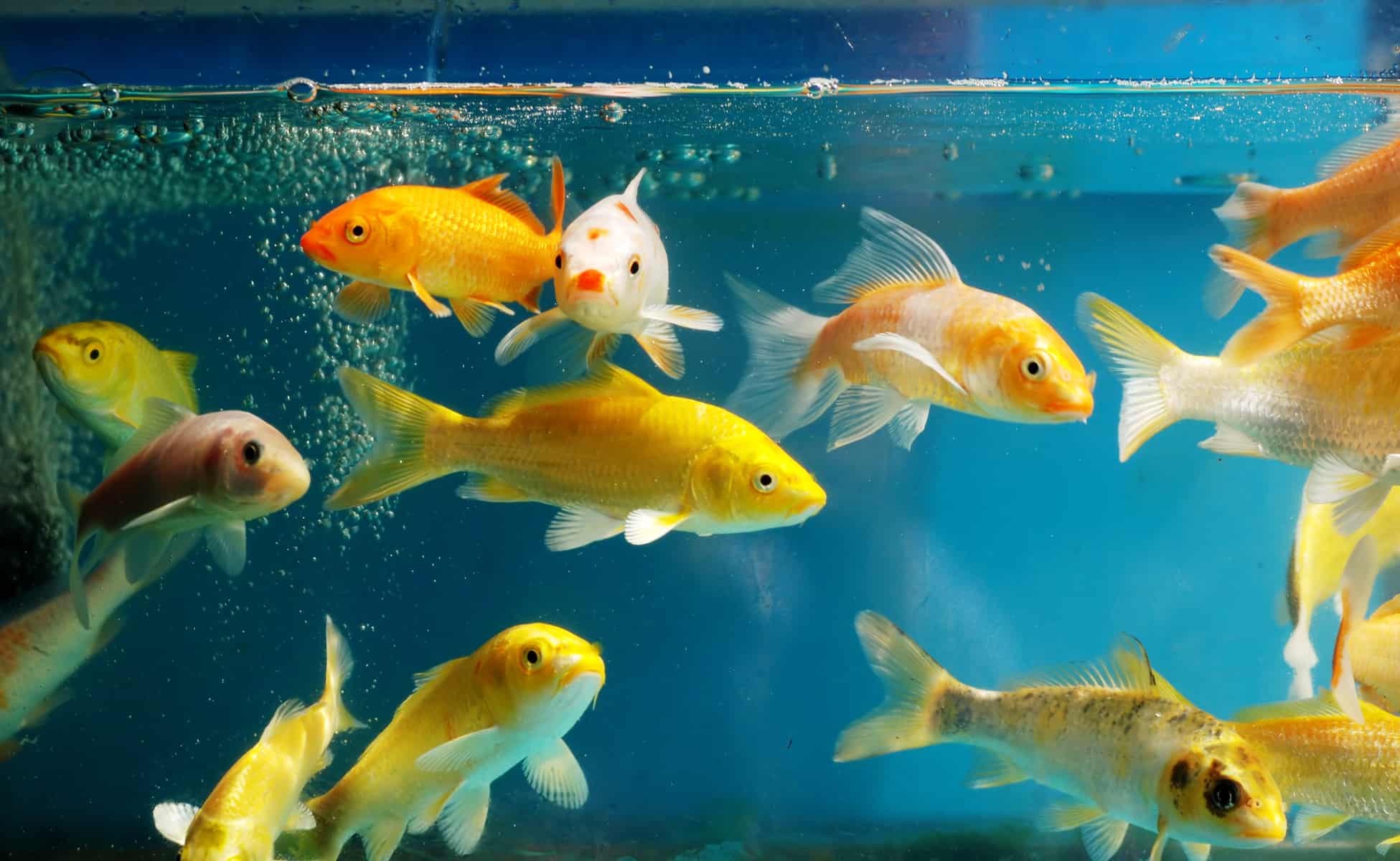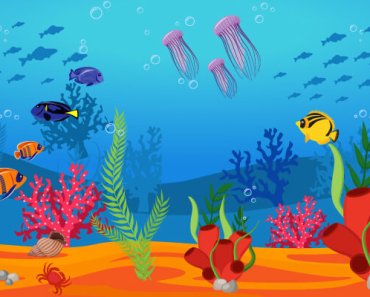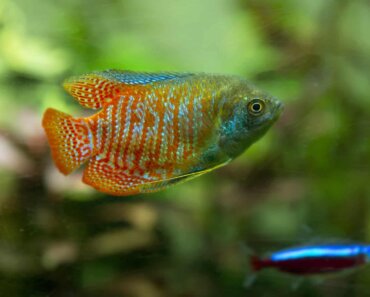Wait. What?
If fish can only live underwater, how can fish drown? It seems like a simple yes/no question, but a lot of things can actually go wrong that would deprive a fish of being able to breathe correctly to the point where the fish could suffocate and ‘drown.’ Some reasons for this would be low oxygen levels in the water, other unstable water parameters, parasites, and diseases, or even poor selective breeding.
Keep reading to find out everything you need to know about how oxygen is dissolved in water, how fish breathe, and what could lead to a fish drowning.
Dissolved oxygen
In order to understand how oxygen levels in water affect fish, it is important to look at how oxygen moves from the air into the water in the first place. Dissolved oxygen (DO) is the scientific measurement used to determine how much oxygen is in the water and ready to be used by living organisms. Dissolved oxygen is influenced by a lot of factors, including depth, temperature, atmospheric exchange, outside sources, and photosynthesis.
Depth and temperature
Cold water will hold more dissolved oxygen and warm water will hold less dissolved oxygen. This means that when surface water temperatures are low (as long as there is no interference of exchange between the air and the water due to ice), dissolved oxygen concentration will be high; when surface water temperatures are high, dissolved oxygen concentration will be low.
Seasons, as well as altitudes and latitudes, greatly affect how much dissolved oxygen is actually available in the water column. Salinity will also influence freshwater concentrations versus saltwater systems. This is one of the main reasons why there is a concern for the average temperature of the Earth rising; as the atmosphere warms, surface waters will also warm and slow down the exchange of oxygen. Those organisms that need oxygen to survive may face declining levels of dissolved oxygen.
Atmospheric exchange
So how does oxygen enter the water column in the first place? One of the main ways oxygen enters the water column is through surface exchange. For the most part, this is accomplished by water mixing with atmospheric oxygen through wind and waves. This means that rivers that are highly turbulent will usually have higher dissolved oxygen concentrations than stagnant lakes.
Outside sources
These rivers eventually feed into larger bodies of water, though, bringing the dissolved oxygen with them and influencing naturally occurring concentrations in those areas. Some of these streams are additionally fed by groundwater, which will also influence dissolved oxygen concentrations.
Photosynthesis
Lastly, like trees undergo photosynthesis, aquatic plants and vegetation also transform carbon dioxide into oxygen while processing their own food. One autotrophic plankton called the phytoplankton is especially important in contributing to dissolved oxygen levels by performing photosynthesis during the day in surface waters.

Respiration
However, those organisms that do not undergo photosynthesis undergo respiration instead, where oxygen is converted into carbon dioxide. This includes fish, snails, crabs, as well as the same phytoplankton that we talked about before!
One of the biggest groups that use respiration is bacteria. As minerals and nutrients enter a system, algae and other photosynthetic organisms begin to thrive in these eutrophic conditions; this is usually caused by the runoff of fertilizers and other nutrient rich-solutions unnaturally entering an ecosystem. The algae can become so thick that the water is stained green and blocks out all light from penetrating past the first few inches of water. This eventually causes aquatic plants to starve due to being unable to undergo photosynthesis.
At the same time, the algae begins to die as the excess nutrients are absorbed and depleted from the water. This is when bacteria start to decompose the decaying algae and other vegetation. Because there is so much of this food to keep the bacteria population thriving, numbers increase and so respiration also increases, depleting oxygen levels as they respire. As these oxygen levels quickly decrease, the water becomes anoxic.
When there is such a lack of oxygen, all organisms that need oxygen to survive usually die. These areas become known as dead zones where aquatic life cannot be supported.
How fish breathe
Fish have gills that allow the fish to breathe. These gills are an extensive network of blood-filled capillaries providing a large surface area for the exchange of oxygen and carbon dioxide. It should be noted that there are fish and invertebrates that can breathe in both the water and out of the water, however, we will not be discussing the physiology of those species in this article. For typical fish:
First, fish take in oxygen through their mouth. They then create pressure in their mouths that drives the water to cross the thin layers of gills. The dissolved oxygen diffuses into the bloodstream due to concentrations of oxygen being lower in the blood than in the surrounding water. Carbon dioxide is also expelled across the gills back out into the water.
But what happens if the fish is pulled backwards and can’t take in water through its mouth, like if on a fishing line?
Can sharks swim backwards?
You may have heard that sharks need to constantly be swimming in order to breathe. While some species are an exception to this rule and can breathe like other fish, in general, it is true and sharks will suffocate if there is no new influx of water across their gills. But can a shark swim backwards?
Sharks are the only type of fish that can’t swim backwards, mainly due to the structure of their pectoral fins which cannot change in curvature. However, if they were able to swim backwards–or dragged to shore by a fisherman–they would also likely suffocate.
Gills are designed to expel and process water and not receive water. The backwards motion would cause water to be forced over the gills, interfering with the regular respiratory process and ultimately resulting in the fish not being able to breathe, eventually leading to ‘drowning.’
The simple answer: can fish drown?
Yes, fish can ‘drown’–for lack of a better word. Though, it is better to think of it as a form of suffocation where oxygen levels are too low or the fish isn’t able to properly pull oxygen from the water for one reason or another. In the sections below, we’ll go further into the reasons why fish might drown.
The long answer
If you’re looking for information as to why your aquarium fish might have drowned, then we need to look at what can cause a lack of oxygen in the water column. We will be looking at algae blooms, poor water conditions, diseases and parasites, and body modifications.
Eutrophication and algae blooms
As we discussed before, an excess of nutrients can cause algae blooms which in turn increase bacteria populations that deplete oxygen levels in the water. If there is not enough oxygen in the water for fish to breathe, then they slowly suffocate.
Some of the worst harmful algae blooms (HAB) are usually a type of bacteria called cyanobacteria, or blue-green algae, which can actually be dangerous for humans; note that not all algae blooms are harmful in the sense that they result in toxic conditions. However, surrounding water can easily be contaminated and cause illness if consumed or swam in.
In these surrounding areas, shellfish may also filter feed through the water, retaining any toxins that are present. Consuming these shellfish can result in paralytic shellfish poisoning (PSP), and those with possible symptoms should seek medical help immediately.
One of the most notorious dead zones is at the mouth of the Mississippi River. This is the result of fertilizers from agricultural centers along the river being washed away until becoming concentrated at the start of the Gulf of Mexico. Many fisheries, shrimp farms, and oyster farms have suffered due to this hypoxic water that does have not enough oxygen available for healthy conditions.

Water conditions
Why can’t you add fish to a newly cycled tank? If you don’t know the answer to this question, then we suggest you read our guide on fish tank cycling here.
Maybe you know not to, but maybe you don’t know the exact reasons why an uncycled tank can be so harmful to a new fish. One of the main problems is that a new tank will undergo a water cycle, starting with ammonia–keep in mind that ammonia can also spike if the tank is overstocked. If there is any ammonia at all in the water column, all fish can be exposed to ammonia poisoning.
Ammonia can cause burns to appear on your fish, which will make gills look like they’re bleeding. This spotting will eventually spread to the rest of the body. At the same time, the fish may be seen gasping for air at the surface of the water, lacking an appetite, and laying at the bottom of the tank. If left in these water conditions for too long, the fish will be unable to get the oxygen that it needs, resulting in the fish drowning.
After ammonia comes nitrite in the cycle, which is another deadly parameter that can quickly kill your fish. Once the fish has been exposed, nitrite enters the bloodstream and binds to hemoglobin where oxygen should have attached, leaving the fish to painfully suffocate and drown.
Parasites and diseases
Fish need gills to breathe dissolved oxygen, but what happens if those gills have been compromised by parasites or disease? Unfortunately, the gills are a very common area for both internal and external parasites to occur in/on fish. Most of these parasites fall within the Monogenenea class, which includes flatworms that are commonly found on the skin or in the gills.
One slimy parasite is the gill fluke (Dactylogyrus genus) which mostly attaches itself to members of the Cyprinidae family, like goldfish, koi, and carp. These flukes are initially free-swimming and then need to find a host after several hours to survive. This usually causes inflamed gills and can cause irritation that makes the fish scratch its gills on hard surfaces. The fish may also struggle to breathe correctly, become lethargic, and have a loss of appetite.
Sadly, many fish succumb to these parasites as they are highly infectious and multiply rapidly. Most fish are either further weakened by other bacterial or fungal infections from scratching and inflammation or are unable to pull enough oxygen from the water, causing the fish to drown.
Even more commonly, aquarium fish usually experience ich (Ichthyophthirius multifiliis), which can settle in the gills and have long-lasting effects if the fish survives.
Fish may also drown due to other factors, such as bacterial or fungal infections. One problem that many Salmonid fisheries experience is bacterial gill disease ( BGD); interestingly, it is believed that this only occurs in the commercial industry and has not affected wild populations of fish yet.
Most notably, these bacteria, Flavobacterium branchiophilum and F. succinicans, cause fish to become lethargic, experience a loss of appetite, and become less responsive to outside stimuli. Exposed fish also tend to station themselves directly in the flow of new water, indicating a need for increased oxygen. If not treated, the fish can die if the bacteria overpopulates and not enough oxygen is successfully passing across the gills.
Another similar bacterial infection is amoebic gill disease (AGD), which can also lead to the fish drowning.
Body modifications
Some of the most beautiful fish in the aquarium trade have been selectively bred to express the most desirable body modifications that can unfortunately cause the fish to drown. One great and sad example of this is the betta fish.
Betta fish are a special fish to consider when it comes to breathing. These fish have a special organ called the labyrinth organ that allows them to go to the surface of the water and gulp in atmospheric air. This organ is believed to have developed out of a need for more oxygen in water with low oxygen levels. Betta fish can also pull oxygen from the water via gills like other fish.
Betta fish varieties with long tails also have the ability to go to the surface of the water to gasp at air and pull in water through their gills. However, these fish have been so overly bred that their tails drag them down, making it difficult to emerge to breathe air or even swim at all. Because of this, these fish become exhausted and usually end up leaning on the side of a decoration or at the bottom of the aquarium.
If there is little water movement in the tank, oxygen will be depleted fast with your fish struggling to breathe and unable to get additional air. Once the fish has taken as much oxygen as it can from the water column via its gills and if it is still unable to swim to the surface of the water for air, the fish will drown.
If you are looking into getting a betta fish, make sure to research as much information as you can to prevent this from happening. If you already have a betta fish with a long tail, make sure that there is adequate water movement (without making it more difficult for the fish to swim) and keep the water well oxygenated. If you would like more information on how excessive finnage can lead to drowning, find our rosetail betta – downside of beauty post here.
Conclusion
Can fish drown? Absolutely. And having your fish drowning is definitely not a pleasant experience.
Keep dissolved oxygen levels up in your aquarium by having lots of water movement and exchange with air at the surface. Maintain water parameters, look out for parasites and diseases, and avoid fish that have modified bodies, and hopefully, you won’t need to experience what happens when fish drown.
If you have any more questions about why fish need oxygen, how fish can drown, or how air interacts with water, don’t hesitate to leave a comment below!


























